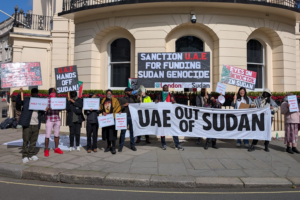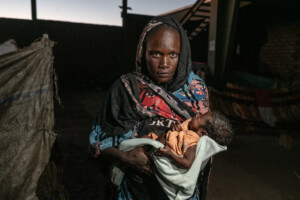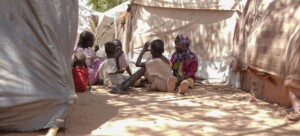Sudan OCHA bulletin 19: Tens of thousands affected by watery diarrhoea, heavy rains
Over 30,700 cases of acute watery diarrhoea were reported throughout the country, reports Federal Ministry of Health. Almost 64,000 people affected by heavy rains and flash floods throughout the country. According to UNHCR there are over 424,000 South Sudanese refugees in Sudan. And the Qatar Fund for Development donates $70million towards development projects in Darfur, reports the Office for the Coordination of Humanitarian Affairs (OCHA) reported in its latest biweekly bulletin.
Over 30,700 cases of acute watery diarrhoea were reported throughout the country, reports Federal Ministry of Health. Almost 64,000 people affected by heavy rains and flash floods throughout the country. According to UNHCR there are over 424,000 South Sudanese refugees in Sudan. And the Qatar Fund for Development donates $70million towards development projects in Darfur, reports the Office for the Coordination of Humanitarian Affairs (OCHA) reported in its latest biweekly bulletin.
According to the Federal Ministry of Health (FMoH) and the World Health Organization (WHO) as of 18 August 2017, 30,762 cases of Acute Watery Diarrhoea (AWD)—including 657 related deaths—have been reported in the 18 states in the country since August 2016. Based on the attack rate projections another 36,000 to 40,000 cases are expected over the next six to nine months, according to the FMoH and WHO. The AWD is affecting all demographics, with females constituting 54 per cent of the cases and children under five years of age accounting for 8.1 per cent.
In order to control the current outbreak, the FMoH is leading government efforts and is working closely with WHO, the UN Children’s Agency (UNICEF) and partners to minimise the spread of AWD through activities in public health capacity-building. During the past week WHO staff continued supporting 14 treatment centres serving about 1.4 million people in nine states in collaboration with the FMoH. Several new treatment centres have additionally been established in South Darfur, including support to East Jebel Mara and Kalma Camp. WHO also supported State Ministries of Health and health partners with supplies for the treatment of 27,500 AWD patients in all 18 states.
In East Darfur, 42 rapid response team (RRT) members were given additional training and 876 house-to-house campaigns were carried out reaching 2,876 people.
The UN Children’s Agency (UNICEF) continued its comprehensive response activities for AWD working with the Ministries of Health and Water at federal and state levels. UNICEF also distributed 33 million chlorine tablets, 610,000 soaps and 27,000 jerry cans to households.
Almost 64,000 people affected by heavy rains and flash floods throughout the country
As of 24 August 2017, heavy rains and flash floods affected 63,945 people across 11 states, which is an increase of 21,034 from last week, according to the government’s Humanitarian Aid Commission (HAC) and partners. The newly affected people include 2,130 in East Darfur, 870 in Khartoum, 545 in River Nile, 840 in North Darfur, 2,370 in Northern State, 1,575 in South Darfur and 12,704 in White Nile State.
During a mission to assess the effects of floods on 24 August 2017, community leaders reported that 168 homes were destroyed (affecting about 840 people) and 168 were damaged (affecting about 850 people) and that all possessions were washed away due to the flooding of Wadi Golo. The International Organization for Migration’s (IOM) Displacement Tracking Matrix team also reported that the market in Zamzam camp was submerged, damaging goods and 168 latrines collapsed.
On 23 August, a joint team including HAC carried out a mission to assess the impact of floods in Otash IDP camp, South Darfur. The team found that 315 families (about 1,600 people) had been affected by floods and are in need of emergency shelter and household supplies.
In July, flooding in White Nile State destroyed the shelters of at least 1,100 host community households in Al Salaam locality. Ongoing rains have made most roads to refugee camps impassable, reducing humanitarian access to many of them. The majority of refugees who arrived in Sudan since mid-December 2013—about 164,000 (40 per cent)—have taken refuge in White Nile State.
Over 424,000 South Sudanese refugees in Sudan
According to UNHCR’s latest Population and Operational Update, as of 15 August, 180,592 South Sudanese refugees have arrived in Sudan in 2017, for a total of 424,182 refugees who have fled hunger and violence in South Sudan since mid-December 2013. The majority of new arrivals in 2017 have taken refuge in White Nile, East Darfur, South Darfur and South Kordofan states.
Since 1 July, about 10,500 refugees have arrived in South Darfur, including 2,900 refugees who came between 1-15 August. New arrivals report crossing the border from Western Bahr Ghazal State in South Sudan, fleeing escalating conflict and hunger. Based on the current trends, aid organisations are preparing contingency plans for an estimated 30,000 – 40,000 additional refugees who are anticipated to arrive in South Darfur by January 2018.
Qatar Fund for Development donates $70million
On 21 August, the Qatar Fund for Development (QFFD) announced, during a signing ceremony held in Khartoum, a US$70 million donation towards development projects in Darfur that aim at encouraging displaced people in the state to return to their home areas. This is the second phase of Qatar’s initiative for the development of Darfur. The projects will be implemented over a five-year period and will benefit 300,000 people, according to QFFD – in villages in all five Darfur states. Projects include initiatives to help returnees find livelihood opportunities and become economically empowered as well as initiatives to establish peace and social cohesion. The projects include establishment of service centres with two primary and two secondary schools, a health centre, a police station, a mosque, and 15 houses for the service centre employees.











 and then
and then